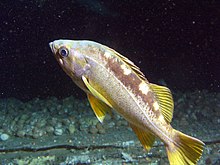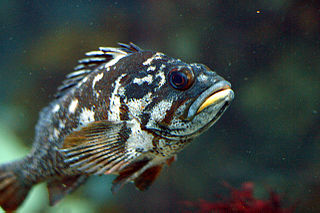
The gopher rockfish, also known as the gopher sea perch, is a species of marine ray-finned fish belonging to the subfamily Sebastinae, the rockfishes, part of the family Scorpaenidae. It is found in the eastern Pacific, primarily off California.

The blue rockfish or blue seaperch, is a species of marine ray-finned fish belonging to the subfamily Sebastinae, the rockfishes, part of the family Scorpaenidae. It is found in the northeastern Pacific Ocean, ranging from northern Baja California to central Oregon.

The China rockfish, the yellowstripe rockfish or yellowspotted rockfish, is a species of marine ray-finned fish belonging to the subfamily Sebastinae, the rockfishes, part of the family Scorpaenidae. It is native to the waters of the Pacific Ocean off western North America.

The canary rockfish, also known as the orange rockfish, is a species of marine ray-finned fish belonging to the subfamily Sebastinae, the rockfishes, part of the family Scorpaenidae. It is native to the waters of the Pacific Ocean off western North America.

The Pacific ocean perch, also known as the Pacific rockfish, rose fish, red bream or red perch, is a fish whose range spans across the North Pacific : from southern California around the Pacific rim to northern Honshū, Japan, including the Bering Sea. The species appears to be most abundant in northern British Columbia, the Gulf of Alaska, and the Aleutian Islands.

The shortraker rockfish is an offshore, demersal species of marine ray-finned fish belonging to the subfamily Sebastinae, the rockfishes, part of the family Scorpaenidae. It is found in the northern Pacific Ocean.

The bocaccio rockfish is a species of marine ray-finned fish belonging to the subfamily Sebastinae, the rockfishes, part of the family Scorpaenidae, It is found in the northeast Pacific Ocean.

The shortspine thornyhead, also known as the channel rockcod, shortspine channel rockfish or spinycheek rockfish, is a species of marine ray-finned fish belonging to the subfamily Sebastinae, the rockfishes, part of the family Scorpaenidae. It is sometimes referred to as the "idiot fish" or "idiot cod" due to its large oversized head and eyes. It is found in the northern and northeastern Pacific Ocean.
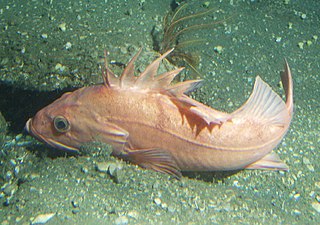
Sebastes levis, the cowcod or cow rockfish, is a species of marine ray-finned fish belonging to the subfamily Sebastinae, the rockfishes, part of the family Scorpaenidae. It is found in the eastern Pacific Ocean.

The widow rockfish, or brown bomber, is a species of marine ray-finned fish belonging to the subfamily Sebastinae, the rockfishes, part of the family Scorpaenidae. It is found in the northeastern Pacific Ocean.

Sebastes goodei, the chilipepper rockfish and chilipepper, is a species of marine ray-finned fish belonging to the subfamily Sebastinae, the rockfishes, part of the family Scorpaenidae. This species lives mainly off the coast of western North America from Baja California to Vancouver.

The yelloweye rockfish is a species of marine ray-finned fish belonging to the subfamily Sebastinae, the rockfishes, part of the family Scorpaenidae and one of the biggest members of the genus Sebastes. Its name derives from its coloration. It is also locally known as "red snapper", not to be confused with the warm-water Atlantic species Lutjanus campechanus that formally carries the name red snapper. The yelloweye is one of the world's longest-lived fish species, and is cited to live to a maximum of 114 to 120 years of age. As they grow older, they change in color, from reddish in youth, to bright orange in adulthood, to pale yellow in old age. Yelloweye live in rocky areas and feed on small fish and other rockfish. They reside in the East Pacific and range from Baja California to Dutch Harbor in Alaska.

The black rockfish, also known variously as the black seaperch, black bass, black rock cod, sea bass, black snapper and Pacific Ocean perch, is a species of marine ray-finned fish belonging to the subfamily Sebastinae, the rockfishes, part of the family Scorpaenidae. It is sometimes misidentified as the "red snapper".
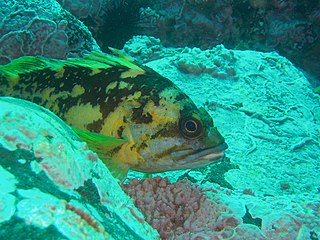
Sebastes chrysomelas, commonly known as the black-and-yellow rockfish, is a marine fish species of the family Sebastidae. It is found in rocky areas in the Pacific off California and Baja California. Although it is similar in appearance to the China rockfish, the black-and-yellow rockfish lacks the China's long yellow streak. The China rockfish has a continuous yellow band while the black-and-yellow rockfish only has scattered patches of yellow across its body.
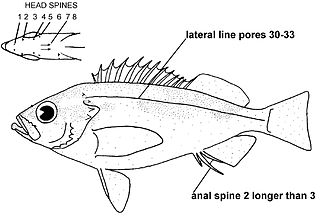
Sebastes rufinanus, the dwarf-red rockfish, is a species of marine ray-finned fish belonging to the subfamily Sebastinae, the rockfishes, part of the family Scorpaenidae. It is found in the Eastern Pacific, in tock habitats off islands in southern California.

Sebastes diploproa, the splitnose rockfish, is a species of marine ray-finned fish belonging to the subfamily Sebastinae, the rockfishes, part of the family Scorpaenidae. It is found in the northeastern Pacific Ocean.

Sebastes elongatus, the greenstriped rockfish, striped rockfish, strawberry rockfish, poinsettas, reina or serena, is a species of marine ray-finned fish belonging to the subfamily Sebastinae, the rockfishes, part of the family Scorpaenidae. It is found in the northeastern Pacific Ocean.

Sebastes serranoides, the olive rockfish, is a species of marine ray-finned fish belonging to the subfamily Sebastinae, the rockfishes, part of the family Scorpaenidae. It is found in the Eastern Pacific.
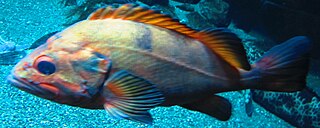
Sebastes melanostictus, the blackspotted rockfish, is a species of marine ray-finned fish belonging to the subfamily Sebastinae, the rockfishes, part of the family Scorpaenidae. It is found in the northern Pacific Ocean.

The Deacon Rockfish is a marine ray-finned fish belonging to the subfamily Sebastinae, which is part of the family Scorpaenidae. Its body is compressed with large pectoral fins, prominent head ridges, well-developed spines, and large eyes, making it well-adapted for life along rocky substrates-from which its common name is derived. Native to the Eastern Pacific Ocean, Deacon Rockfish ranges from British Columbia to central California where it is found on nearshore and offshore rocky reefs.
